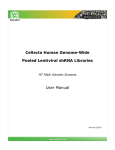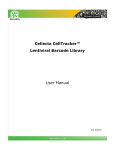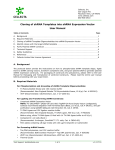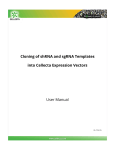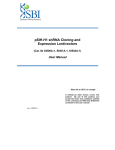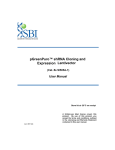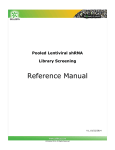Download Cloning of shRNA Templates into shRNA Expression
Transcript
Cloning of shRNA Templates into shRNA Expression Vectors User Manual v3a, 8-29-2013 Cloning of shRNA Templates into shRNA Expression Vectors User Manual www.cellecta.com www.decipherproject.net Table of Contents Page A. Background 2 B. Required Materials 2 C. Cloning of shRNA Template Oligonucleotides into shRNA Expression Vector 3 D. Identify clones with the target shRNA template 4 E. Purify Plasmid shRNA Construct 4 F. Technical Support 5 G. Safety Guidelines 6 H. Appendix 7 I. 1. Lentiviral shRNA Expression Vector Maps 2. Common Lentiviral Vector Features 7 9 Terms and Conditions 10 A. Background The protocols below provide the instructions on how to phosphorylate shRNA template oligos, ligate them to shRNA cloning vectors, transform competent cells, and grow plasmid DNA to generate plasmid shRNA expression constructs. For packaging of constructs into pseudovirus, please refer to the User Manual for Packaging and Transduction of Lentiviral Constructs. Please read the entire user manual before proceeding with your experiment. B. Required Materials For Phosphorylation and Annealing of shRNA Template Oligonucleotides • • T4 Polynucleotide Kinase and 10X reaction buffer (Recommended: New England BioLabs T4 Polynucleotide Kinase, 10 U/µl, Cat. # M0201S) rATP (Recommended: GE/Amersham, Cat. # 27-2056-01) For Ligating and Transforming shRNA Constructs • • • • Linearized shRNA Expression Vector T4 DNA Ligase and 10X ligation reaction buffer (Recommended: New England BioLabs, T4 DNA Ligase, 400 U/µl. Cat. # M0202S) Before using, dilute T4 DNA-ligase 10-fold with 1X T4 DNA ligase buffer to 40 U/µl.) Competent E. coli cells (RecA-) (Recommended: Invitrogen, OmniMAX™ 2 T1 cells, Cat. # C8540-03) Petri plates containing LB Agar media with 100 µg/ml Ampicillin or Carbenicillin For Screening shRNA Inserts • • • • • Taq DNA polymerase, and 10X reaction buffer (Recommended: BDB Clontech Titanium™ Taq DNA polymerase, Cat. # 639208) dNTP mix (Recommended: GE/Amersham, dNTP set, Cat. # 27-2035-01) Thermal Cycler 3% 1X TAE Agarose gel PCR Screening Primers (IDT): o Forward (FwdU6-2): 5’- CCTAGTACAAAATACGTGACGTAGAA -3’ o Reverse (R3301-3LTR): 5’- TGGTCTAACCAGAGAGACCCAGTA -3’ To verify the screening primers for non-standard and custom vectors, please email [email protected]. Cellecta, Inc. 2 of 10 v.3a, 8/29/13 Cloning of shRNA Templates into shRNA Expression Vectors User Manual www.cellecta.com www.decipherproject.net For Purifying shRNA Constructs after Cloning • Plasmid purification kit (Recommended: QIAGEN Endotoxin-free Plasmid Kit. The following kit combinations can be used for Midi scale preparation of endotoxin-free DNA: QIAfilter Plasmid Midi Kit, Cat. # 12243, and EndoFree Plasmid Maxi Kit, Cat. # 12362 QIAfilter Plasmid Midi Kit, Cat. # 12243, and EndoFree Plasmid Buffer Set, Cat. # 19048 Please visit the QIAGEN website to download the specialized protocol that is not contained in the user manual: http://www1.qiagen.com/literature/protocols/pdf/QP15.pdf C. Cloning of shRNA Template Oligonucleotides into shRNA Expression Vector 1. Phosphorylate and Anneal the shRNA Template Oligonucleotides Note: This protocol was developed for regular non-phosphorylated oligos. If your oligonucleotides are already phosphorylated, dilute them to 10 µM in 1X T4 polynucleotide kinase buffer, heat at 95°C for 2 min and anneal as in steps 1.d-1.e below. a. Dissolve the shRNA template oligonucleotides in an appropriate amount of deionized water to a final concentration of 20 µM. b. Set up 20 µl phosphorylation/annealing reactions for each shRNA template: 1 1 2 2 13 1 µl µl µl µl µl µl 20 µl Top Strand shRNA template oligo (20 µM) * Bottom Strand shRNA template oligo (20 µM) * 10X T4 Polynucleotide Kinase Buffer 5 mM ATP Deionized water T4 Polynucleotide Kinase (10 U/µl) Total volume * For the insert-minus control, use 2 µl deionized water in place of the top and bottom strands. c. Incubate the phosphorylation reaction at 37°C for 30 minutes in a thermocycler. d. Heat the reaction mix to 95°C for 2 min in a thermocycler. e. Turn off the thermocycler and let it cool to room temperature. f. Take a 2 µl aliquot from the reaction (1 µM shRNA template), and make a 1:5 dilution by adding 8 µl of 1X T4 Kinase buffer. Mix well. g. Use 0.5 µl of the diluted shRNA template (0.2 µM) for the following ligation reaction. 2. Ligate the shRNA Template into Linearized shRNA Lentivector a. Set up 10 µl ligation reactions for each phosphorylated shRNA template as follows: 1.0 0.5 1.0 6.5 1.0 10.0 µl µl µl µl µl µl Linearized shRNA Expression Vector (10 ng/µl) (see Required Materials) Phosphorylated ds shRNA template (step 1; 0.2 µM) * 10X T4 DNA Ligase Buffer Deionized water T4 DNA ligase (40 U/µl) ** Total volume * For negative control use insert-minus. ** Dilute T4 DNA ligase (400 U/µl) 10-fold to 40 U/µl with 1X T4 DNA ligase buffer if you are using New England Biolabs enzyme. b. Incubate the ligation reaction at 16°C for 1-2 hrs. Cellecta, Inc. 3 of 10 v.3a, 8/29/13 Cloning of shRNA Templates into shRNA Expression Vectors User Manual www.cellecta.com www.decipherproject.net 3. Transform E. coli with the ligation product a. For each shRNA template, use the whole volume of ligation product for transformation. b. Follow the manufacturer’s protocol for transforming the competent cells. c. Plate an appropriate amount of cells on LB plates with 100 µg/ml ampicillin or carbenicillin and grow overnight at 37°C. d. You should expect to get at least 10-fold more colonies in experimental samples in comparison with negative control (vector-only ligation reaction). D. Identify clones with the target shRNA template 1. Prepare colony cultures a. Randomly pick up 10 well-separated colonies from each plate, and grow each clone in 100 µl of LB Broth with 100 µg/ml ampicillin or carbenicillin at 37°C for 2 hours with shaking. b. Take 1 µl of each bacteria culture for PCR screening (see B.2) and continue to grow the culture for another 6 hours. c. Store the bacterial culture at 4°C. 2. Screen for shRNA template inserts a. Prepare a PCR master mix for each clone you would like to screen for the presence of an shRNA template insert as follows: 1 rxn 0.5 µl 0.5 µl 0.5 µl 2.5 µl 19.5 µl 0.5 µl 24.0 µl 10 rxn 5 µl 5 µl 5 µl 25 µl 195 µl 5 µl 240 µl Composition Forward PCR Primer (10 µM)* Reverse PCR Primer (10 µM)* 50X dNTP mix (10 mM of each) 10X PCR Reaction Buffer Deionized water Taq DNA Polymerase (5 U/µl) Total volume *See Appendix. b. Mix the master mix very well and aliquot 24 µl into each well of a 96-well PCR plate or individual tubes. c. Add 1 µl of each bacterial culture from B.1 into each well or tube from B.2.b. Mix. d. Proceed with PCR using the following program: 94°C, 4 min 94°C, 0.5 min, then 68°C, 1 min 68°C, 2 min 1 cycle 25 cycles 1 cycle e. Take 5 µl of PCR product from step d and run it on a 3% agarose/EtBr gel in 1X TAE buffer. f. Confirm identity of shRNA template inserts by sequence analysis of positive PCR products using the Forward PCR primer. E. Purify Plasmid shRNA Construct a. Take 15 µl of each positive bacteria culture from Step B.1.c, inoculate each clone in 10 ml of LB broth media with 100 µg/ml ampicillin or carbenicillin, and grow overnight at 37°C with shaking. b. Purify shRNA lentivector construct plasmid DNA in Midi or Maxi scale using an Endotoxin-free plasmid purification kit. Cellecta, Inc. 4 of 10 v.3a, 8/29/13 Cloning of shRNA Templates into shRNA Expression Vectors User Manual www.cellecta.com www.decipherproject.net F. Technical Support For additional information or technical assistance, please contact us: Phone: Toll-Free: Fax: +1 (650) 938-3910 +1 (877) 938-3910 +1 (650) 938-3911 E-mail: Technical Support: General Information: Sales: Orders: Blog: [email protected] [email protected] [email protected] [email protected] http://www.cellecta.com/blog/ Postal Mail: Cellecta, Inc. 320 Logue Ave. Mountain View, CA 94043 For more information about Cellecta’s products and services, please visit our web site at http://www.cellecta.com. Cellecta, Inc. 5 of 10 v.3a, 8/29/13 Cloning of shRNA Templates into shRNA Expression Vectors User Manual www.cellecta.com www.decipherproject.net G. Safety Guidelines The HIV-based lentivector system is designed to maximize its biosafety features, which include: • A deletion in the enhancer of the U3 region of 3’ΔLTR ensures self-inactivation of the lentiviral construct after transduction and integration into genomic DNA of the target cells. • The RSV promoter upstream of 5’LTR in the lentivector allows efficient Tat-independent production of viral RNA, reducing the number of genes from HIV-1 that are used in this system. • Number of lentiviral genes necessary for packaging, replication and transduction is reduced to three (gag, pol, rev). The corresponding proteins are expressed from different plasmids lacking packaging signals and share no significant homology to any of the expression lentivectors, pVSV-G expression vector, or any other vector to prevent generation of recombinant replication-competent pseudovirus. • None of the HIV-1 genes (gag, pol, rev) will be present in the packaged pseudoviral genome, as they are expressed from packaging plasmids lacking packaging signal—therefore, the lentiviral particles generated are replication-incompetent. • Pseudoviral particles will carry only a copy of your expression construct. Despite the above safety features, use of HIV-based vectors falls within NIH Biosafety Level 2 criteria due to the potential biohazard risk of possible recombination with endogenous viral sequences to form self-replicating pseudovirus or the possibility of insertional mutagenesis. For a description of laboratory biosafety level criteria, consult the Centers for Disease Control Office of Health and Safety Web site at: http://www.cdc.gov/od/ohs/biosfty/bmbl4/bmbl4s3.htm It is also important to check with the health and safety guidelines at your institution regarding the use of lentiviruses and follow standard microbiological practices, which include: • Wear gloves and lab coat at all times when conducting the procedure. • Always work with pseudoviral particles in a Class II laminar flow hood. • All procedures are performed carefully to minimize the creation of splashes or aerosols. • Work surfaces are decontaminated at least once a day and after any spill of viable material. • All cultures, stocks, and other regulated wastes are decontaminated before disposal by an approved decontamination method such as autoclaving. Materials to be decontaminated outside of the immediate laboratory area are to be placed in a durable, leakproof, properly marked (biohazard, infectious waste) container and sealed for transportation from the laboratory. Cellecta, Inc. 6 of 10 v.3a, 8/29/13 Cloning of shRNA Templates into shRNA Expression Vectors User Manual www.cellecta.com www.decipherproject.net H. Appendix 1. Lentiviral shRNA Expression Vector Maps* (Standard pRSI12, pRSI16, and Customized) Cellecta, Inc. 7 of 10 v.3a, 8/29/13 Cloning of shRNA Templates into shRNA Expression Vectors User Manual www.cellecta.com www.decipherproject.net RSV 5’LTR Cellecta pRSI shRNA Expression Lentiviral Vector. AmpR Fully Customizable. RRE pRSI-U6-(sh)-UbiCRFP-2A-Puro pUC ORI U6 ~7.5 - 8.5 kb cPPT (Default features shown) shRNA promoter: BbsI BbsI U6 H1 U6-Tet H1-Tet UbiC SV40 ORI SV40 PolyA Marker promoter: RFP 2A PuroR Markers: for constitutive shRNA expression, any combination of 2 markers (GFP, RFP, PuroR, BleoR, NeoR, Hygro-HK, etc.) hUbiC hEF1 hPGK CMV CMV/Ferritin for tet-regulated shRNA expression, any combination of Tet Repressor (TetR) and one or two markers (GFP, RFP, PuroR, BleoR, NeoR, Hygro-HK, etc.) Standard library expression vector used for library construction. Specific variations shown are available with custom libraries. For sequences and cassette designs for Cellecta vectors, please see the Cellecta website: http://www.cellecta.com/resources/vectors or contact Cellecta at [email protected]. * All Cellecta lentiviral vectors, including the DECIPHER vectors, are covered by a lentiviral expression system license owned by Life Technologies Corporation (LTC). See Terms and Conditions. Cellecta, Inc. 8 of 10 v.3a, 8/29/13 Cloning of shRNA Templates into shRNA Expression Vectors User Manual www.cellecta.com www.decipherproject.net 2. Common Lentiviral Vector Features Feature Rous Sarcoma Virus (RSV) enhancer/promoter HIV-1 truncated 5′ LTR HIV-1 psi (ψ) packaging signal HIV-1 Rev response element (RRE) U6 cPPT UbiC promoter TagRFP 2A (T2A) PuroR WPRE ∆U3/HIV-1 truncated 3′ LTR SV40 polyadenylation signal SV40 Ori AmpR pUC ori Function Allows Tat-independent production of viral mRNA (Dull et al., 1998). Source Rous sarcoma virus Permits viral packaging and reverse transcription of the viral mRNA (Luciw, 1996). HIV-1 Allows viral packaging (Luciw, 1996). HIV-1 Permits Rev-dependent nuclear export of unspliced viral mRNA (Kjems et al., 1991; Malim et al., 1989). Human U6 promoter drives RNA Polymerase III transcription for generation of shRNA transcripts. Central polypurine tract, cPPT, improves transduction efficiency by facilitating nuclear import of the vector's preintegration complex in the transduced cells. Ubiquitin C promoter drives expression of TagRFP and PuroR. TagRFP fluorescent protein (Evrogen) serves as an indicator of successful transduction. Thosea asigna virus 2A translational cleavage site containing 18 amino acid residues. Cleavage occurs via a co-translational ribosome skipping mechanism between the C-terminal glycine and proline residues, leaving 17 residues attached to the end of TagRFP and 1 residue to the start of the puromycin resistance marker (in the DECIPHER vectors). Puromycin-resistant marker for selection of the transduced cells. Woodchuck hepatitis virus posttranscriptional regulatory element— enhances the stability of viral transcripts. 3' Self-inactivating long terminal repeat. Allows viral packaging but self-inactivates the 5′ LTR for biosafety purposes (Dull et al., 1998). The element also contains a polyadenylation signal for transcription termination and polyadenylation of mRNA in transduced cells. Required for viral reverse transcription; selfinactivating 3' LTR with deletion in U3 region prevents formation of replication-competent viral particles after integration into genomic DNA. Allows transcription termination and polyadenylation of mRNA. Allows for episomal replication of plasmid in eukaryotic cells. Ampicillin resistance gene (β-lactamase) for selection of plasmid in bacterial cells. pUC bacterial origin of replication. HIV-1 Human HIV-1 Human sea anemone Entacmaea quadricolor Thosea asigna virus Streptomyces alboniger Woodchuck hepatitis virus HIV-1 SV40 SV40 bacterium Salmonella paratyphi pUC * (c): element on complementary strand Cellecta, Inc. 9 of 10 v.3a, 8/29/13 Cloning of shRNA Templates into shRNA Expression Vectors User Manual www.cellecta.com www.decipherproject.net I. Terms and Conditions Cellecta, Inc. Limited License Cellecta grants the end user (the “Recipient”) of the Product a non-transferable, non-exclusive license to use the reagents for internal research use only as described in the enclosed protocols; in particular, research use only excludes and without limitation, resale, repackaging, or use for the making or selling of any commercial product or service without the written approval of Cellecta, Inc. -- separate licenses are available for non-research use or applications. The Product is not to be used for human diagnostics or included/used in any drug intended for human use. Care and attention should be exercised in handling the Product by following appropriate research laboratory practices. Cellecta’s liability is expressly limited to replacement of Product or a refund limited to the actual purchase price. Cellecta’s liability does not extend to any damages arising from use or improper use of the Product, or losses associated with the use of additional materials or reagents. This limited warranty is the sole and exclusive warranty. Cellecta does not provide any other warranties of any kind, expressed or implied, including the merchantability or fitness of the Product for a particular purpose. Use of the Product for any use other than described expressly herein may be covered by patents or subject to rights other than those mentioned. Cellecta disclaims any and all responsibility for injury or damage that may be caused by the failure of the Recipient or any other person to use the Product in accordance with the terms and conditions outlined herein. The Recipient may refuse these licenses by returning the enclosed Product unused. By keeping or using the enclosed Product, you agree to be bound by the terms of these licenses. The laws of the State of California shall govern the interpretation and enforcement of the terms of these Licenses. Limited Use Label Licenses The Recipient acknowledges that the Product has been developed by Cellecta based on licenses from Third Parties and agrees with the Terms of Limited Use for the Recipient provided by the Third Parties: Life Technologies Corporation End-User Label License for the use of Lentiviral Expression System: “This product or service (based upon the Lentiviral Expression System) is sublicensed from Life Technologies Corporation under U.S. Patent Nos. 5,686,279; 5,834,256; 5,858,740; 5,994,136; 6,013,516; 6,051,427; 6,165,782; 6,218,187; 6,428,953; 6,924,144; 7,083,981 and 7,250,299 and corresponding patents and applications in other countries for internal research purposes only. Use of this technology for gene therapy applications or bioprocessing other than for nonhuman research use requires a license from GBP IP, LLC. Please contact GBP IP, LLC 537 Steamboat Road, Suite 200, Greenwich, CT 06830. Use of this technology to make or sell products or offer services for consideration in the research market requires a license from Life Technologies Corporation, 5791 Van Allen Way, Carlsbad, CA 92008.” Evrogen IP JSC End-User Label License for the use of lentiviral shRNA constructs comprising TagRFP-encoded gene: “This product is for internal non-commercial research use only. No rights are conveyed to modify or clone the gene encoding fluorescent protein contained in this product. The right to use this product specifically excludes the right to validate or screen compounds. For information on commercial licensing, contact Evrogen Licensing Department, email: [email protected]”. © 2013 Cellecta, Inc. All Rights Reserved. Trademarks CELLECTA is a registered trademark of Cellecta, Inc. Cellecta, Inc. 10 of 10 v.3a, 8/29/13











